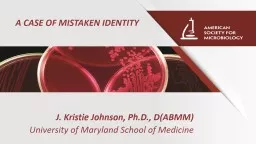

University of Maryland School of Medicine A CASE OF MISTAKEN IDENTITY Patient History A 39yearold previously healthy Amish woman was admitted to the burn unit after sustaining burns on 56 of her body ID: 913358
Download Presentation The PPT/PDF document "J . Kristie Johnson, Ph.D., D(ABMM" is the property of its rightful owner. Permission is granted to download and print the materials on this web site for personal, non-commercial use only, and to display it on your personal computer provided you do not modify the materials and that you retain all copyright notices contained in the materials. By downloading content from our website, you accept the terms of this agreement.
Slide1
J. Kristie Johnson, Ph.D., D(ABMM)University of Maryland School of Medicine
A CASE OF MISTAKEN IDENTITY
Slide2Patient HistoryA 39-year-old previously healthy Amish woman was admitted to the burn unit after sustaining burns on 56% of her body. Because the patient’s immune system was suppressed and she developed a high grade fever, she was treated empirically with 2 broad spectrum antimicrobial agents: piperacillin/
tazobactam
and vancomycin
.Five days after antimicrobial therapy was introduced, the patient reported moderate abdominal pain and bloody diarrhea; her temperature was 103.6°F.A stool sample was sent to the lab.
Photo Credit: J. Kristie Johnson, Ph.D., D(ABMM)
Slide3Common Causes of Diarrhea BacterialCampylobacter jejuniSalmonella spp.Shigella
spp.
Escherichia coli
Yersinia enterocoliticaVibrio choleraeClostridium difficileViralNorovirusRotavirusCytomegalovirus Parasitic Giardia lambliaCryptosporidium
Slide4Processing a Stool Sample for Bacterial Pathogens
Stool samples are sent to the microbiology
laboratory.
Stool samples are plated onto selective media for bacterial pathogens in a biological safety
hood.
After incubation, plates are examined for bacterial
pathogens.
Photos show growth that might be observed following plating of stool
samples.
Photo Credit: J. Kristie Johnson, Ph.D., D(ABMM)
Slide5Microbiology Laboratory ResultsAll cultures were negative for common bacterial pathogens that cause diarrhea.In fact there was no growth of any of the types of bacteria found in “normal stool”But the non-selective agar plate (MacConkey agar) was full of mucoid pink colonies!
The clinical microbiologist reported this unusual finding to the patient’s physician.
Slide6Antibiotic Associated Hemorrhagic Colitis (AAHC) caused by K. oxytoca
Klebsiella
oxytoxaGram-negative rod.Encapsulated (colonies appear mucoid).Pink colonies indicate the organism ferments lactose.Often associated with urinary tract, wound, or bloodstream infections.Not considered a common cause of bacterial diarrhea.
Gram-negative rod on Gram Stain
Mucoid lactose-fermenting colonies on
MacConkey
agar
Diagnosis!
Photo Credit: J. Kristie Johnson, Ph.D., D(ABMM)
Slide7More on the diagnosis…. Klebsiella oxytocaSeveral studies have documented a strong association between K.
oxytoca
in stool
and antibiotic-associated hemorrhagic colitis (AAHC) in C. difficile-negative patients.Toxin production by K. oxytoca is the key pathogenic factorToxin is a cytotoxin that is chromosomally encodedCytotoxin is weak compared to C. difficile toxin A (tcdA, resulting in antibiotic-associated colitis (AAC)).
Slide8Explanation of DiagnosisK. oxytoca AAHC vs C. difficile AACImportant characteristics distinguishing K. oxytoca
AAHC and
C. difficile AAC
Adapted from Green, NM et al. 2009. Clin. Microbiol. Newsletter. 31: 111-116. Provided by Nicole Green, Ph.D., D(ABMM).
Characteristic
Klebsiella
oxytoca
– AAHC
Clostridium difficile - AAC
Pseudomembrane
No
YesBloody diarrheaYesNo
Antibiotic class associationΒ-lactams
Β-lactams
TreatmentWithdraw antibiotic
Requires additional antibiotics
Complications
MinimalToxic
megacolon, intestinal perforation, deathOutbreak-associated
No
Yes
Slide9Patient OutcomeBroad spectrum antimicrobial therapy inhibited the growth of normal stool bacteria and allowed the K. oxytoca to grow (e.g., “selected for” K. oxytoca).
Antimicrobial therapy was
discontinued
and the patient recovered.The clinical microbiologist was instrumental in diagnosing this unusual cause of diarrhea!
Slide10J. Kristie Johnson, Ph.D., D(ABMM)
Dr. Johnson is an Associate Professor at the University of Maryland School of Medicine, Departments of Pathology and Epidemiology and Public Health and Microbiology and Immunology and the Interim Director of the Clinical Microbiology and Virology Laboratories at the University of Maryland Medical Center
. Dr
. Johnson is a Diplomate of the American Board of Medical Microbiology and has expertise in public health and medical microbiology. Dr. Johnson’s research focuses on the detection, transmission, and control of antimicrobial resistant organisms concentrating on methicillin resistant Staphylococcus aureus (MRSA) and resistant Gram-negative bacteria to include multi-drug resistant
Enterobacteriaceae (KPC, ESBLs, and plasmid mediated AmpC), Acinetobacter baumannii, and Pseudomonas aeruginosa.
Photo Credit: J. Kristie Johnson, Ph.D., D(ABMM)